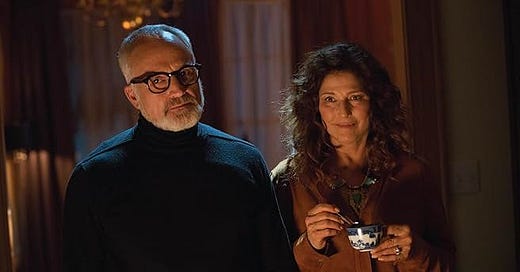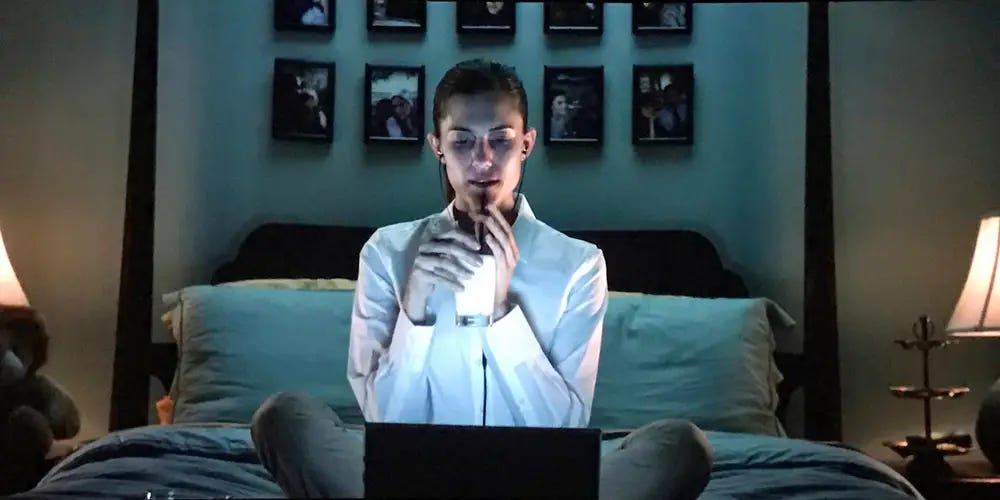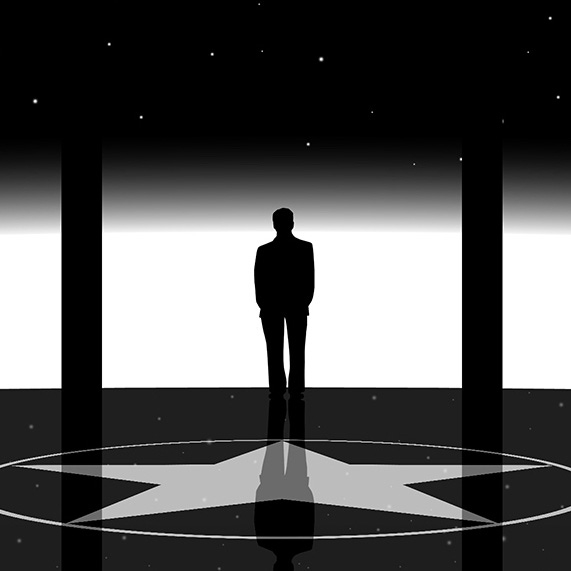The first time I watched Jordan Peele’s extraordinary movie, Get Out (2017), was at the Cinemark Polaris 18 on the north side of Columbus, Ohio. Outside the I-270 ring road. That means amid the very nice suburbs inhabited predominantly by middle and upper-middle class white Ohioans. You know. Buckeye fans (likely intolerable now what with their latest National Championship). That whole thing.
Imagine my surprise—my wonderment—then, as a cultural theorist, when I witnessed during the incredible finale of Peele’s film this well-heeled Caucasian movie-going audience cheering for what they’ve been trained to hate and fear most: a young black man committing violence to a wealthy white family.
Holy shit! (I said to myself.) How the hell did Jordan Peele pull that off?
If most white Americans were to watch the killing spree by Chris Washington (Daniel Kaluuya) inside the Armitage mansion without the benefit of knowing the plotline leading up to it, we (yup, I’m in this sad cohort) likely would imagine the action-packed sequence (watch here and here) to depict an especially macabre home invasion and car theft. After all, in countless ways both overt and subtle, American whites are taught to believe that young black men are monster-like threats to our dominant status quo. Out of lust and poverty and a brute nature, so the doctrine goes, young black men are ever eager to rape and steal from and kill white people.
Especially terrifying to whites is the idea of this violence occurring in our suburban enclaves (such as north of the I-270 ring road in Columbus, Ohio), where we’ve retreated to be well clear of any terrifying mixed-race carnage.
How astonishing is it, then—if you stop to think about it—to have a cineplex full of suburban white Ohioans thrilled and relieved to see Chris 1) impale Dean Armitage (Bradley Whitford) with a buck antler; 2) escape the hypnotist clutches of Missy Armitage (Catherine Keener)—but not be shown Chris actually killing this white women because Peele is no idiot; 3) stomp Jeremy Armitage (Caleb Landry Jones) to death, and, finally; 4) leave his two-faced seductress, Rose Armitage (Allison Williams) for dead?
Whew. That’s a lot of rich white folk buying the farm. How the hell did Peele pull that off? And why the hell, almost a decade after the film came out, should we care?
I’ll answer each question in turn.
The rest of this post (and a little bit into the next) will be spent answering Question 1—that is, how Peele works his filmic magic. Coming your way in two weeks, the second part of my analysis of Get Out will offer some answers to Question 2—that is, why Peele’s film still packs a social punch.
Answers to Question 1: How Peele Works His Filmic Magic
Jordan Peele pulls off this masterwork of sociopolitical inversion—that is, getting affluent white people to cheer for a rampaging black guy—by way of genre invasion. That is, in Get Out, Peele invades the conventions of the traditional horror film to give us instead, in his words, “a social thriller.”
Using his filmmaker sleight-of-hand, Peele does much more than awaken thrilling horror in movie audiences. He awakens us to the appalling terror of white supremacy in America—and in particular to the racism of the superrich.
In simple horror-flick terms, Chris is the hero escaping the haunted house. In terms of Peele’s idea-rich social thriller, Chris is transformed from a threatening black marauder of white stereotyping into an innocent victim courageously fighting back against the powerful and evil forces of racism.
The haunted house of horrors Chris escapes is one of white wealth, privilege, and power.
I’ll review some of Peele’s best genre-bending devices.
Genre-Bending Device #1: Mad Scientists
As a film predicated on body-snatching, Get Out has at its core a team of mad scientists—Missy and Dean Armitage.
White, educated, affluent, and middle-aged, Missy and Dean initially present themselves as liberal in their politics and open-minded in their social attitudes. In fact, they are chilling practitioners of some utterly weird—and wholly racist—science.
Missy is an accomplished psychiatrist and expert hypnotherapist. Dean is an eminent neurosurgeon. Together, they entrap young black men, mind and body, in order to carry out what is described as the “coagula procedure.” This is a surgery where, in order to prolong life and renew sexual potency, the brains of rich white old men are put into the vigorous bodies of young black men.
Rich old white men, by the way, who are the highest bidder at latter-day slave auctions run by the Armitage family on their secluded estate.
By the end of the film, Dean in particular has transformed into a full-on Klansman Dr. Frankenstein. Along with delivering the standard thrill-ride story-arc of horror, Peele triggers in viewers excruciating reminders of American slavery, racist violence, and the ownership of bodies.
A cinematic ambush designed to make moviegoers squirm in their cushioned cineplex seats.
Genre-Bending Device #2: Distortion and Exaggeration
Far from being subtle in his hijacking of the horror movie genre, Peele is overt about it. The trappings of horror are heightened to nearly derisive levels in Get Out. Atmospheric music, tension-filled moments, anxiety-producing camera angles, and the like are embellished to the brink of being ham-fisted.
But, of course, these are not amateurish mistakes. They are finely calculated prompts alerting us to the filmic manipulation at work. The best way for Peele to exploit the horror genre, twisting it toward his own social messages, is to call the viewer’s attention to the formulaic workings of the genre. This maneuver enables the audience to see through the generic techniques of horror in order to perceive, just below the surface of the film, the profoundly disturbing story of racism being told in Get Out (watch, for example, this creepy little scene).
By way of this brinksmanship, Peele gooses the familiar shtick of horror to a degree that focuses our minds on the genuine horror of American racism.
Genre-Bending Device #3: The White Monster
At the true heart of all horror movies is the Monster. In the creation of his key ingredient to horror, Peele inverts the white/black binary. Innocent, law-abiding white folk are not made the victims in Get Out. Young black man thugs are not portrayed as the Monsters. Contrary to all racial social conditioning in America, Chris is the victim in Peele’s horror scenario. The Monster is the Armitage family.
And, to be precise, the Armitage family represents the neoliberal, 1%, white supremacists who rule America.
Here are three telling traits Peele builds in to his creation of the White Monster.
Trait #1: the White Monster is intergenerational
The intergenerationally of this Monster is represented by the three generations of the Armitage family in the film.
The grandparents, Roman (Richard Herd) and Marianne (not portrayed in her white body), display good old-fashioned, old-timey racism from the early- and mid-twentieth century. Not only do they use dated slang such as “doggone” and “funny business,” but their beliefs about African Americans center around black physical superiority but mental inferiority as well as whites needing to caretake blacks, such as when the grandmother—in the body of the black housemaid, Georgina (Betty Gabriel)—assures Chris: “The Armitages are so good to us. They treat us like family.” Along with the grandfather, who inhabits the black body of the groundskeeper, Walter (Marcus Henderson), this patriarch-matriarch pair oversee, in the Armitage manor house and lands, what amounts to a Gothic sci-fi slave plantation.
The middle generation of Armitages, Missy and Dean, along with being mad scientists, represent limousine-liberal racism. Theirs is a post-1960s seeming acceptance and toleration of racial difference. They say politically correct things (such as Dean declaring to Chris, “I would have voted for Obama for a third term if I could. Best president in my lifetime, hands down”) and they display progressive social attitudes (such as warmly welcoming their daughter’s black boyfriend). But beneath the broadminded veneer lurks bigotry as intense as that of the previous generation.
The youngest generation of Armitage, brother and sister Jeremy and Rose, embody two different Millennial manifestations of racism. Jeremy is an outright white nationalist, simultaneously belligerent and craven. Like his grandfather, he regards black men as physically advantaged but intellectually deficient. Jeremy also sees black men as threats to be bested and adversaries to be destroyed.
Drunk and rambling at the family dinner table, Jeremy, when he discovers that Chris took jiu-jitsu lessons as a kid, treats the information as some kind of challenge to his white manhood. Focusing weaselly, frat-bro eyes on Chris, Jeremy white-mansplains to him: “The thing about jiu-jitsu is strength doesn’t matter, right? It’s all about this. [Points to his head.] It’s a strategic game, like chess. It’s all about being two ... three ... four moves ahead.” His implication is, of course, that white men are smarter than black men.
It’s a gruesome but gratifying moment when, during the climatic sequence of Get Out, Chris outsmarts this young white supremacist, breaking free of Jeremy’s jiu-jitsu chokehold then killing him.
For her part, Rose enacts her younger-generation racism contrariwise to Jeremy. Instead of directing hatred towards black men, she pretends to love them. Chris is not the first black man she has procured then lured home to be prepared for consumption by whites. Rose’s real passion, then, is appropriation. While seeming to love African Americans and their culture, Rose is really only interested in using them for her own gain. This attitude and behavior reflects the race-relations phenomenon identified by cultural theorist bell hooks in the 1990s as “eating the Other.”
But I’ll have a lot more to say about Rose below.
Trait #2: the White Monster is ubiquitous and inescapable
White supremacy has always been the dominant ideology in America. It only makes sense, then, that the White Monster in Get Out is terrifyingly limitless in its reach and power. Peele drives home this point, however, in a unique way—through satiric exaggeration. Whiteness is everywhere in the film, but Peele de-normalizes white upper-middle class culture by constantly calling the viewer’s attention to it with myriad farcical and cringeworthy details.
To point out but a few: Dean and Chris discuss progressive politics while standing in a gazebo; all the rich, old, country-club-type white guests at the Armitage weekend event are obvious twits and assholes; Jeremy takes a swing at Chris with a lacrosse stick; the décor of the Armitage house is Pottery Barn chic; they have carrot cake for dessert; the basement rec room where Chris is held prisoner is straight out of Whitebread Hell.
In other words, that which is revered in American society as the accoutrements of wealth and prestige is sardonically transformed by Peele into menacing particulars of the White Monster. We see with new eyes white supremacy not as a special achievement of and justified entitlement for an exceptional group of people, but as a widespread and seemingly benign practice of violent oppression and abuse.
Trait #3: the Monstrous White Girl
Nowhere is this satiric pulling-back-of-the-curtain on white supremacy more trenchant than in Peele’s creation of the primary monster of his deadly-serious, tongue-in-cheek horror flick: the Monstrous White Girl. With the character of Rose, Peele renders topsy-turvy hundreds of years of white supremacist narrative about the perilous relationship between white women and black men. Get Out reverses all racist rhetoric upon which thousands of lynchings of black men in America were predicated: the murderous lust of black men for white women.
Black men in this movie are the victims and the prey. Their predator is an attractive young white woman who is single-minded and ruthless in the hunt. Rose comes across as sociopathic, in fact, in her white supremacy (watch her in psychopath mode here). At this point, we’ll return to bell hooks’ influential essay, “Eating the Other: Desire and Resistance.” Hooks theorizes how race and ethnicity in American culture have “become commodified as resources for pleasure.” In particular, black culture—music, fashion, sports, attitudes, language—has been embraced by the dominant white culture (especially youth culture) as trendy and cool (and lucrative), but mainly in ways where “the Other can be continually exploited, and that such exploitation will occur in a manner that reinscribes and maintains the status quo.”
A large part of this ingesting of the exotic dark Other is sexual and involves breaking American taboos against miscegenation. Hooks notes how non-white bodies “can be seen as constituting an alternative playground where members of dominating races, genders, sexual practices affirm their power-over in intimate relations with the Other.” This approach to racial difference sums up Rose’s white supremacist attitude and trickery towards black men. Rose has no more regard for Chris than any other consumer item that gives her pleasure and brings her status.
Meanwhile, according to hooks, the black Other is devoured and erased:
... the commodification of difference promotes paradigms of consumption wherein whatever difference the Other inhabits is eradicated, via exchange, by a consumer cannibalism that not only displaces the Other but denies the significance of that Other’s history through a process of decontextualization.
Such an eradication is clearly what the Armitage family has in mind for Chris. Rose, like her limousine-liberal parents, personifies the type of white supremacist monster that is likely the most sinister to black people: the racist who pretends to accept and even to admire you.
Thus Peele recasts the character of Rose from being the traditional object of male black temptation and lust into being the most lethal agent of white power.
The most unnerving-cum-mordant depiction of Rose as the Monstrous White Girl occurs while Chris is in the process of fighting his way out of the Armitage home. During this sequence of extreme violence, we cut to Rose in her bedroom upstairs, sitting calmly cross-legged on her bed with earphones in listening to the song “Time of My Life” from the film Dirty Dancing (1987). Not only is that movie very white, but the song lyrics, in this situation, could not be more ironic: “Now I’ve had the time of my life / No, I never felt like this before / Yes I swear it’s the truth / And I owe it all to you...”
On her laptop, Rose—now that she’s delivered Chris to market—is searching for her next young black man victim. Rose appears to have a basketball player in mind this time. Behind her on the wall, over her headboard, are photographs of her past ten victims. These pictures are hung like trophies and signal that the bed and sexuality are the environs of her hunt. Topping the caustic and embellished traits Peele gives to this wicked white girl, however, is Rose having at hand a small bowl of Fruit Loops along with a glass of milk. While searching the internet for the next body to snatch, she selects a single Fruit Loop, bites it in half with care, then chews meticulously. She washes that down with three strictly measured sips of milk through a straw.
Thus we have the monster at the heart of Get Out: a neurotic and soulless serial temptress whose obsessive purpose is the seduction and consumption of black men. Rose is a racialist Siren whose song lures African American men into believing that social equality is available to them. To their horror, these men find themselves instead abducted, packaged, and sold to white masters.
In short, Rose is a slave trader.
Equally, Rose is an embodiment of the white supremacist orthodoxy upon which America is founded and under which people of color suffer to this day. She represents the lie of the American Dream: you can be anything you want to be—so long as you’re white.
END OF PART 1
COMING IN TWO WEEKS: the exciting Part 2 of “Get Out: Now More Than Ever”...
AND DON’T FORGET...
Read some provocative fiction. Check out and subscribe to my other Substack newsletter, 2084 Quartet at:
While you’re at it, read some provocative social commentary. Check out and subscribe to this absolute Substack gem as well:










Jordan Peele was really on to something, wasn't he?